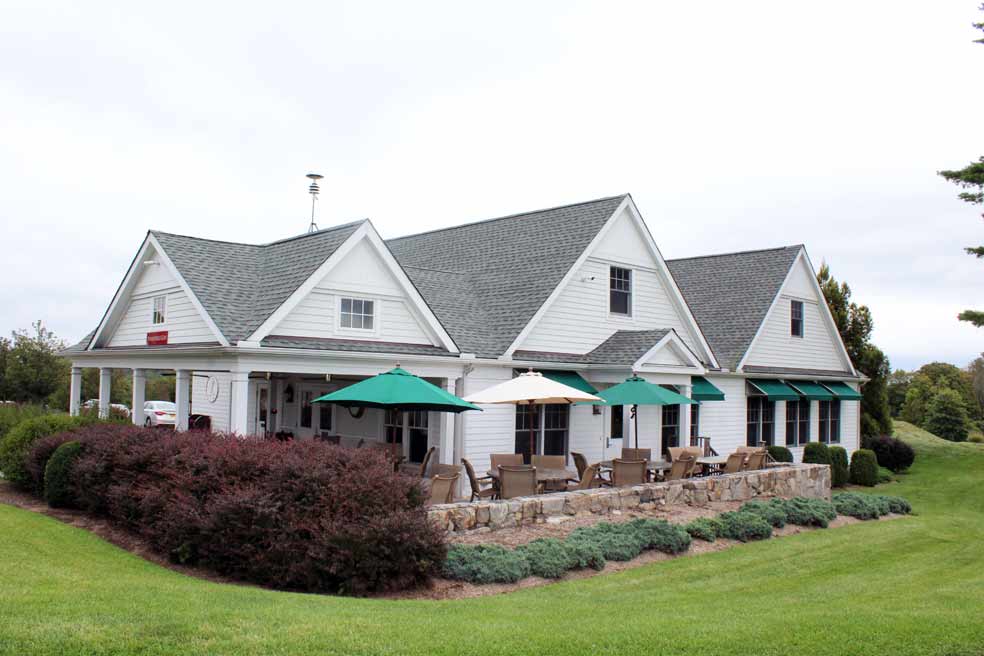
While many people think of golf courses as not being part of the hospitality industry unless they”™re associated with a resort, the U.S. Bureau of Labor Statistics lumps hospitality and leisure together in an industry sector which includes arts, entertainment, recreation, accommodations and food services.
That puts Ken Wang”™s Pound Ridge Golf Club squarely in the hospitality sector because, even though there”™s no resort attached to it, offering hospitality is at the core of what has kept people coming in and shouting “fore.” It”™s a par 72, 18-hole course.
“I had not anticipated that it”™s really a word-of-mouth business and it takes a long time to build a reputation. So the early years, financially, were not great,” he told the Business Journal during an interview on the patio of the clubhouse at 18 High Ridge Road in Pound Ridge at the New York state border with Connecticut. “I like to think we”™ve turned that corner and now, particularly this year when the weather”™s been quite good on weekends, the play is substantially up.”
Famed golf course designer Pete Dye was responsible for creating what Wang describes as a challenging yet playable course. He said when Dye played golf he was very precise with his shots and his course designs reflect precision. One feature, the 13th hole, was designed with a giant boulder in the middle of the fairway.
Wang recalled being introduced to Pound Ridge in 1980 when his father, Cheng, bought land in order to build a country home. Some years later, tennis was in fashion.
“That was the sport of choice. Not many people were playing golf,” he said. “As a family we were always interested in real estate and owning property.”
Wang said he and his father also wanted a place where they could “knock a golf ball around. The original property was, I think, about 350 acres or something and at the time there was an 18-hole golf course. It had been an old private country club and had fallen into great disrepair over the years.”
It turned out that the property had been optioned by a developer.
“We contacted him and he said that he didn”™t want to sell the Connecticut side, the Stamford side,” Wang said.
Zoning was for 1-acre lots on the Stamford portion of the property, whereas the Pound Ridge zoning required minimum 3-acre lots.
“It wasn”™t economical for him to develop housing on the 3-acre side, so he said, ”˜I”™ll sell you what”™s left,”™ and that”™s actually what happened,” he said. “He ended up developing on the Stamford side and we ended up buying the remainder. It gave us about 172 acres and 9 1/2 holes and we just kind of kept it as a little, privately owned public golf course.”
Wang said they were content to have a young golf pro run the course.
“We were happy with the land investment long term and, obviously, whenever we came up he”™d let us get out on the course,” Wang said.

After several years of not doing anything special to improve or promote the course, according to Wang, “At some point we kind of looked at each other, my dad and I, and said we should either turn this into housing, which was a tempting thing to do, or we should make it a proper golf course. To be blunt, we couldn”™t bring ourselves to develop it. It was too pretty a property.”
That”™s when they brought in Dye, who had been responsible for designing numerous world-renowned golf courses and winning awards for his work.
The Wangs had plenty of business expertise to help them be comfortable with their decision not to turn the land into a housing development. Cheng Wang in 1948 joined with three fellow graduates of MIT to found U.S. Summit Co. Ken Wang is now president of U.S. Summit, which distributes pharmaceutical, health care and consumer products throughout Asia and also has historically been active in such diverse fields as oil refining, industrial chemicals, transportation and telecommunications equipment. It”™s headquartered in Pound Ridge. He also was an MIT graduate and is a former president of the MIT Club of New York. His sister is noted fashion designer Vera Wang.
“Part of the rationale for making it a golf course was, in fact, if you look at the area, there historically have been comparatively few public golf courses,” he said. “There are a number of really famous courses in the area ”” Quaker Ridge, Winged Foot, Westchester Hills ”” but there was a real dearth of public courses. Pete Dye is very much an advocate of public golf. It was an opportunity to bring public golf to an area where there really isn”™t a lot of it.”
Westchester County operates several public golf courses and Wang said that while golfers who use those courses might like to try playing a course designed by Pete Dye, “I don”™t think competitively in the sense of saying we want to steal things from other people.”
He believes golfers should try a variety of courses to see which ones best fit their skills.
“I would expect that a certain percentage of people would stick. They would come back,” he said. “A certain percentage would say, ”˜Thanks, it”™s been fun, but it”™s not what I wanted to do.”™ ”
Wang said one thing that surprised him about the golf business is the segmentation in the market.
“You have people who are country club people and they don”™t want to play with anyone but their country club folks,” he said. “You have public golfers who want to play publicly and don”™t mind mingling with anyone else when you match them in a foursome. You have people who want to come and spend a good deal of time and hang out in the ambiance of the club, others who change their shoes in the parking lot and jump into their car and head home right away.”
Wang sees good golfers, bad golfers, golfers who come just for fun, golfers who linger to enjoy a beverage and the club”™s hospitality and those who take the game and every stroke very seriously.
“I think part of the challenge of running this place and part of the challenge of running any golf facility, maybe any business today, is trying to figure out what the appropriate segments are for your business and then trying to figure out how to market to them,” he said.




















